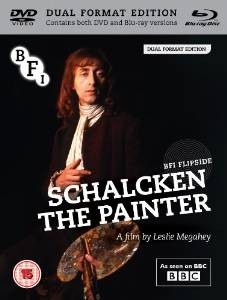 Schalcken the Painter, based upon an 1839 short story by Sheridan Le Fanu, is an extraordinary gem of a film that amply proves the power of the classic ghost story to shock and haunt.
Schalcken the Painter, based upon an 1839 short story by Sheridan Le Fanu, is an extraordinary gem of a film that amply proves the power of the classic ghost story to shock and haunt.
The DVD, recently reissued by the BFI, was given to me by Chris as a gift this Christmas. I’d never heard of the film before, though Chris remembers it from when it originally aired, as part of the BBC’s Omnibus series, appropriately enough at Christmas in 1979.
The story is a simple one: Godfried Schalcken (who is real, by the way – Le Fanu’s story doubles as an insightful commentary on his art) is apprenticed to the master painter Gerrit Dou in the Dutch town of Leiden. Schalcken is fiercely talented, but penniless. When he falls in love with Dou’s niece, Rose, he has little hope that they’ll be allowed to marry, a prospect that is entirely dashed when Dou effectively sells Rose to the enigmatic Mijnhir Vanderhausen of Rotterdam. Dou is uneasy about the contract, especially since he knows nothing about the mysterious suitor, nor has even seen his face, but when faced with the sheer splendour of Vanderhausen’s riches, he finds he cannot refuse.
When it is revealed to Rose that her future husband is ugly to the point of deformation, she begs Schalcken to run away with her. He refuses, pleading poverty – a moment that shocked me back to the fateful conversation between Natasha and Rudin in Turgenev’s Rudin – a decision which is to haunt him for the rest of his life.
Schalcken makes some desultory efforts to find Rose, but when these fail he is quick to seek solace in the tavern and in the brothel – also in his newly found fame as an artist, which is increasing rapidly. He is given one chance to redeem himself – and fails miserably. Dou never quite gets over the devil’s bargain he has made either, and goes to his grave still in agony over the unknown fate of his niece. Alone in the church after the funeral, Schalcken is finally granted the answers he has sought for so long – and wishes he hadn’t been.
The form the film takes is a gloriously simple recitation (by Charles Gray) of Le Fanu’s text, with the sparse dialogue spoken by the actors in a deliberately studied manner. The cinematic art that accompanies the words is incandescent. Every frame echoes a Dutch painting – the magisterial still-lifes, portraits and vanitases of Vermeer and van Hoogstraaten are referenced both directly and indirectly, to include extraordinary tableaux vivants as Dou and Schalcken clothe and arrange their models in scenes of allegory. The technical skill in achieving the colour and ambience of these paintings – the effect is sometimes so striking as to be uncanny – must have been considerable.
The moment of quiet horror when Vanderhausen’s visage is first revealed is sensational, reminding me of the equally pivotal and terrifying moment in Lynch’s Lost Highway when Fred turns over in bed and sees not the face of his wife looking back at him.
Le Fanu’s narrative accomplishes a tremendous amount in a relatively few pages. Fictions inspired by real works of art are always intriguing. That ‘Strange Episode in the Life of Schalcken the Painter’ manages to combine its percipient art criticism with an equally sharp critique of the position of women in Dutch society at the time makes it all the more compelling. Leslie Megahey’s film brings the text to glowing life in a manner that will amaze and delight anyone interested in art, or horror, and hopefully both. Very highly recommended.